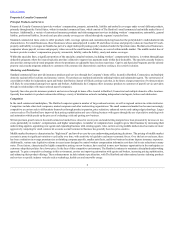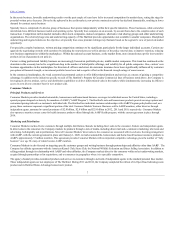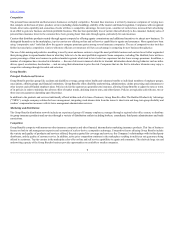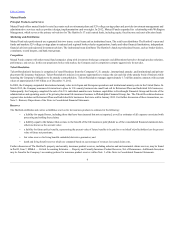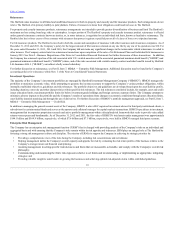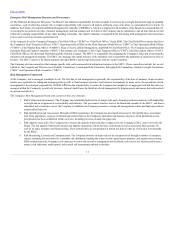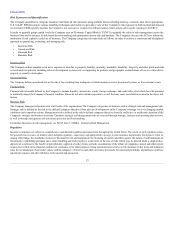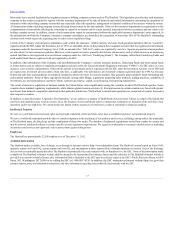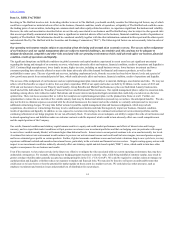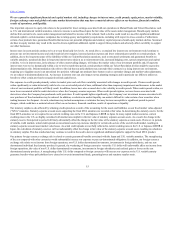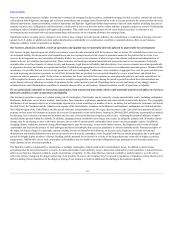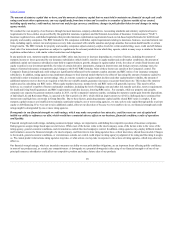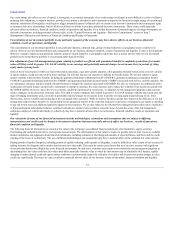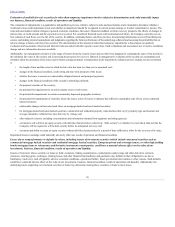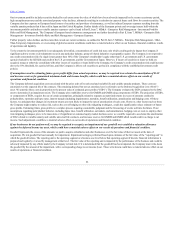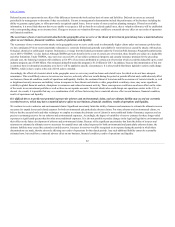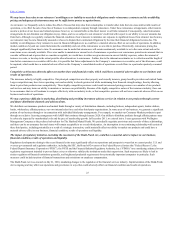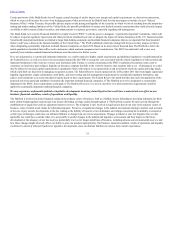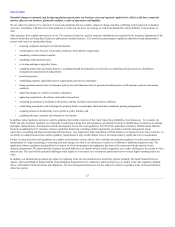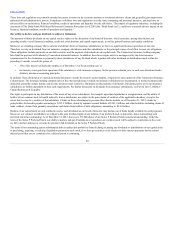The Hartford 2012 Annual Report Download - page 16
Download and view the complete annual report
Please find page 16 of the 2012 The Hartford annual report below. You can navigate through the pages in the report by either clicking on the pages listed below, or by using the keyword search tool below to find specific information within the annual report.
Table of Contents
Our real estate market exposure includes investments in commercial mortgage-backed securities, residential mortgage-backed securities, commercial real estate
collateralized debt obligations, mortgage and real estate partnerships, and mortgage loans. Deterioration in the real estate market in the recent past has adversely
affected our business, financial condition, results of operations and liquidity. Significant further deterioration in the real estate market, including increases in
property vacancy rates, delinquencies and foreclosures, could result in new cycle lows for market values and have a negative impact on sources of refinancing
resulting in reduced market liquidity and higher risk premiums. This could result in impairments of real estate backed securities, a reduction in net
investment income associated with real estate partnerships, and increases in our valuation allowance for mortgage loans.
Significant declines in equity prices, changes in U.S. interest rates, changes in credit spreads, inflation, the strengthening or weakening of foreign currencies
against the U.S. dollar, or global real estate market deterioration, individually or in combination, could have a material adverse effect on our business,
financial condition, results of operations or liquidity.
Our business, financial condition, results of operations and liquidity may be materially adversely affected by unfavorable loss development.
Our success, in part, depends upon our ability to accurately assess the risks associated with the businesses that we insure. We establish loss reserves to cover
our estimated liability for the payment of all unpaid losses and loss expenses incurred with respect to premiums earned on the policies that we write. Loss
reserves do not represent an exact calculation of liability. Rather, loss reserves are estimates of what we expect the ultimate settlement and administration of
claims will cost, less what has been paid to date. These estimates are based upon actuarial and statistical projections and on our assessment of currently
available data, as well as estimates of claims severity and frequency, legal theories of liability and other factors. Loss reserve estimates are refined periodically
as experience develops and claims are reported and settled. Establishing an appropriate level of loss reserves is an inherently uncertain process. Because of this
uncertainty, it is possible that our reserves at any given time will prove inadequate. Furthermore, since estimates of aggregate loss costs for prior accident years
are used in pricing our insurance products, we could later determine that our products were not priced adequately to cover actual losses and related loss
expenses in order to generate a profit. To the extent we determine that losses and related loss expenses are emerging unfavorably to our initial expectations, we
will be required to increase reserves. Increases in reserves would be recognized as an expense during the period or periods in which these determinations are
made, thereby adversely affecting our results of operations for the related period or periods. Depending on the severity and timing of any changes in these
estimated losses, such determinations could have a material adverse effect on our business, financial condition, results of operations or liquidity.
We are particularly vulnerable to losses from catastrophes, both natural and man-made, which could materially and adversely affect our business,
financial condition, results of operations and liquidity.
Our insurance operations expose us to claims arising out of catastrophes. Catastrophes can be caused by various unpredictable events, including earthquakes,
hurricanes, hailstorms, severe winter weather, wind storms, fires, tornadoes, explosions, pandemics and other natural or man-made disasters. The geographic
distribution of our business subjects us to catastrophe exposure for events occurring in a number of areas, including, but not limited to, hurricanes in Florida,
the Gulf Coast, the Northeast and the Atlantic coast regions of the United States, tornadoes in the Midwest and Southeast, earthquakes in California and the
New Madrid region of the United States, and the spread of disease in metropolitan areas. We expect that increases in the values and concentrations of insured
property in these areas will continue to increase the severity of catastrophic events in the future. Starting in 2004 and 2005, third-party catastrophe loss models
for hurricane loss events have incorporated medium-term forecasts of increased hurricane frequency and severity - reflecting the potential influence of multi-
decadal climate patterns within the Atlantic. In addition, changing climate conditions across longer time scales, including the potential risk of broader climate
change, may be increasing, or may in the future increase, the severity of certain natural catastrophe losses across various geographic regions. In addition,
changing climate conditions, primarily rising global temperatures, may be increasing, or may in the future increase, the frequency and severity of natural
catastrophes and increase the potency of viral pathogens and bacterial outbreaks that can cause pandemics or adverse mortality trends. Potential examples of
the impact of climate change on catastrophe exposure include, but are not limited to the following: an increase in the frequency or severity of wind and
thunderstorm and tornado/hailstorm events due to increased convection in the atmosphere, more frequent brush fires in certain geographies due to prolonged
periods of drought, higher incidence of deluge flooding, and the potential for an increase in severity of the largest hurricane events due to higher sea surface
temperatures. Additionally, due to such catastrophes, policyholders may be unable to meet their obligations to pay premiums on our insurance policies or
make deposits on our investment products.
Our liquidity could be constrained by a catastrophe, or multiple catastrophes, which could result in extraordinary losses. In addition, in part because
accounting rules do not permit insurers to reserve for such catastrophic events until they occur, claims from catastrophic events could have a material adverse
effect on our business, financial condition, results of operations or liquidity. To the extent that loss experience unfolds or models improve, we will seek to
reflect any of these changes in the design and pricing of our products. However, the Company may be exposed to regulatory or legislative actions that prevent a
full accounting of loss expectations in the design or pricing of our products or result in additional risk-shifting to the insurance industry.
16


